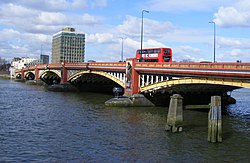
Back كوبرى فوكسهول ARZ Воксхальскі мост Byelorussian Vauxhall Bridge Czech Vauxhall Bridge Danish Vauxhall Bridge German Puente de Vauxhall Spanish Vauxhall zubia Basque پل ووکسهال Persian Vauxhall Bridge French גשר ווקסהול HE
Vauxhall Bridge | |
|---|---|
 | |
| Coordinates | 51°29′15″N 0°07′37″W / 51.48750°N 0.12694°W |
| Carries | A202 road |
| Crosses | River Thames |
| Locale | London |
| Maintained by | Transport for London |
| Heritage status | Grade II* listed |
| Preceded by | Grosvenor Railway Bridge |
| Followed by | Lambeth Bridge |
| Characteristics | |
| Design | Arch bridge |
| Material | Steel and granite |
| Total length | 809 feet (247 m) |
| Width | 80 feet (24 m) |
| No. of spans | 5 |
| Piers in water | 4 |
| Clearance below | 39 feet 9 inches (12.1 m) at lowest astronomical tide[1] |
| History | |
| Designer | Sir Alexander Binnie, Sir Maurice Fitzmaurice |
| Opened | 26 May 1906 |
| Replaces | Regent Bridge (Old Vauxhall Bridge) 1816–98 |
| Statistics | |
| Daily traffic | 50,533 vehicles (2004)[2] |
| Location | |
 | |
Vauxhall Bridge is a Grade II* listed steel and granite deck arch bridge in central London. It crosses the River Thames in a southeast–northwest direction between Vauxhall on the south bank and Pimlico on the north bank. Opened in 1906, it replaced an earlier bridge, originally known as Regent Bridge but later renamed Vauxhall Bridge, built between 1809 and 1816 as part of a scheme for redeveloping the south bank of the Thames. The bridge was built at a location in the river previously served by a ferry.
The building of both iterations of the bridge was problematic, with both the first and second bridges requiring several redesigns from multiple architects. The original bridge, the first iron bridge over the Thames, was built by a private company and operated as a toll bridge before being taken into public ownership in 1879. The second bridge, which took eight years to build, was the first in London to carry trams and later one of the first two roads in London to have a bus lane.
In 1963 it was proposed to replace the bridge with a modern development containing seven floors of shops, office space, hotel rooms and leisure facilities supported above the river, but the plans were abandoned because of costs. With the exception of alterations to the road layout and the balustrade, the design and appearance of the current bridge has remained almost unchanged since 1907. The bridge today is an important part of London's road system and carries the A202 road and Cycle Superhighway 5 (CS5) across the Thames.
- ^ Thames Bridges Heights, Port of London Authority, retrieved 25 May 2009
- ^ Cookson 2006, p. 316
© MMXXIII Rich X Search. We shall prevail. All rights reserved. Rich X Search